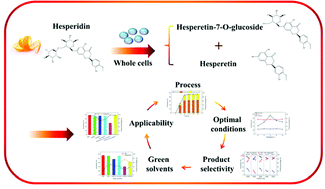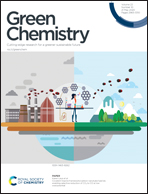Highly efficient bioconversion of flavonoid glycosides from citrus-processing wastes in solvent-buffer systems†
Abstract
An efficient whole-cell biocatalytic method was developed for the cascade hydrolysis of flavonoid glycosides to their valuable hydrolyzates with high substrate conversions. Cells of Aspergillus niger showed both α-L-rhamnosidase and β-D-glucosidase activities, catalyzing the hydrolysis of hesperidin (HES) through two pathways in one pot: (1) α-L-rhamnosidase catalyzed HES hydrolysis to hesperetin-7-O-glucoside (HG) and subsequently β-D-glucosidase catalyzed HG hydrolysis to hesperetin, and (2) β-D-glucosidase catalyzed direct hydrolysis of HES to hesperetin. Both the HES conversion and product composition were controllable by adjusting the key reaction conditions and addition of different sugars. Remarkably, high conversions (above 90%) of HES were achieved by using green solvents in place of traditional organic solvents for dissolving polar substrates. The type and concentration of natural deep eutectic solvents (NADESs) in buffer solutions evidently influenced both the catalytic activity and selectivity of the cells. Inverted fluorescence microscopy and OD260/OD280 analysis suggested that NADESs can enhance the cellular membrane permeability, but high concentration of NADESs may damage cellular membranes and reduce the activity of enzymes. Furthermore, the whole-cell catalysts showed good scaled-up capability and stability. The whole cells also showed a relatively broad substrate spectrum towards various citrus flavonoid glycosides and their derivatives, with substrate conversions of 58.1%–98.2% and monoglycoside percentages of 73.3%–98.9%. This demonstration of whole-cell catalysis for one-pot cascade hydrolysis of flavonoid glycosides offers an eco-friendly, scalable and flexible platform method for the production of useful and valuable flavonoid monoglycosides and aglycones from inexpensive substances.



 Please wait while we load your content...
Please wait while we load your content...